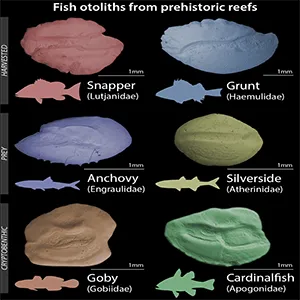When thinking about fossils, we often picture dinosaurs. But reefs can also hold an ancient history. Tiny fish bones and shark scales also become fossils in these habitats, quietly preserving the story of ancient oceans.
A striking study from the Smithsonian Tropical Research Institute (STRI) has now revealed how humans disrupted Caribbean reefs in the past.
Scientists analyzed fossilized coral reefs from Panama’s Bocas del Toro and the Dominican Republic. These reefs, exposed and well-preserved, date back 7,000 years.
Humans changed reef fish communities
The researchers compared the fossilized reefs with nearby living reefs to reveal how overfishing changed fish communities.
In the ancient reef sediments, the team found thousands of fossilized otoliths (fish ear bones) and dermal denticles (shark scales).
These fossils gave clues to species composition and size. The results show a massive shift in predator-prey dynamics, unlike anything seen before.
One of the most alarming findings was a 75% drop in shark numbers. These top predators once played a key role in maintaining reef balance. As their numbers fell, populations of prey fish surged. They doubled in abundance and increased 17% in size.
The predator release effect
The study offers hard evidence for the “predator release effect.” Scientists had long predicted this outcome, but they lacked solid prehistoric data to prove it.
Now, the fossils confirm what models once assumed: removing predators lets prey populations explode.
Meanwhile, fish targeted by humans, like larger groupers and snappers, became 22% smaller. This shrinking trend matches what we observe today.
Overfishing seems to have pushed these species toward early maturity and smaller size.
Some fish stay the same
Remains from tiny cryptobenthic reef fishes, which live in coral crevices, told a different story. Their size and abundance remained unchanged over thousands of years.
Despite fishing and upheaval above them, these reef dwellers stayed stable. Their resilience surprised the researchers.
“The stability of these fish shows remarkable resistance to external pressures,” noted the researchers. Even as top predators vanished and fishing intensified, these hidden species kept going, unchanged.
To measure these shifts, the scientists examined 807 shark denticles and 5,724 otoliths. They also studied coral branches for bite marks left by damselfish.
Fossil and modern samples showed that damselfish now bite more often – likely because they face fewer predators.
Fish bones reveal big reef changes
Otoliths grow in layers like tree rings. This allows scientists to estimate the age and size of fish at time of death. By comparing fossil otoliths with modern ones, researchers could track size changes across millennia.
Dermal denticles, the scale-like structures on shark skin, helped identify shark presence. These tiny features tell a big story: as shark numbers decreased, populations of prey species expanded.

Bite marks from damselfish also gave insights. These aggressive little fish defend territories and leave distinct marks. More bites today means more damselfish – again pointing to the effects of predator loss.
Tracing reef fish history with fossils
This fossil evidence gives scientists a rare and valuable baseline. It shows how Caribbean reef fish communities looked before human fishing began to alter their structure.
Without such deep-time context, conservation efforts often rely on incomplete or recent data that miss the full picture of ecological change.
Now, researchers and reef managers can clearly see which parts of the reef ecosystem shifted due to human influence – and which components, like tiny reef-sheltered fish, remained stable across millennia.
“This study demonstrates the power of the fossil record for future conservation,” the researchers stated.
Long-term impacts of human activity
These 7,000-year-old fossils give us a clearer view of the long-term impacts of human activity on reef food webs, fish sizes, and predator-prey dynamics.
They also help identify which reef species and relationships are most at risk from continued pressure.
By looking back in time through the fossil record, scientists gain crucial insight to guide better decisions in reef conservation, fishing policies, and biodiversity management today.
The research was a collaboration among top institutions including the Smithsonian Tropical Research Institute (STRI), the Marine Science Institute at the University of Texas, Austin, and the Center for Biodiversity Outcomes at Arizona State University.
The study is published in the journal Proceedings of the National Academy of Sciences.
—–
Like what you read? Subscribe to our newsletter for engaging articles, exclusive content, and the latest updates.
Check us out on EarthSnap, a free app brought to you by Eric Ralls and Earth.com.
—–
